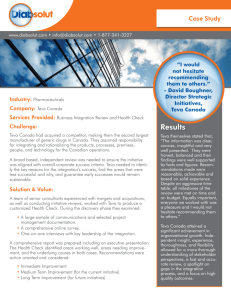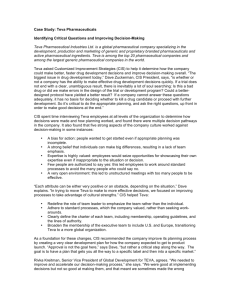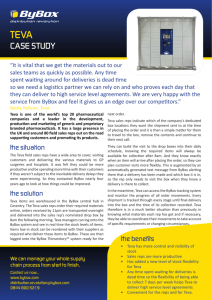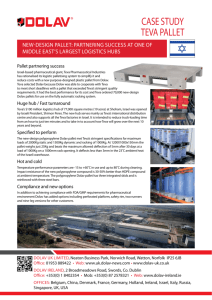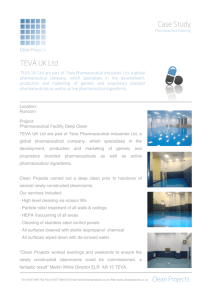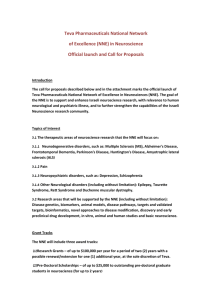I.The Teva Decision
advertisement
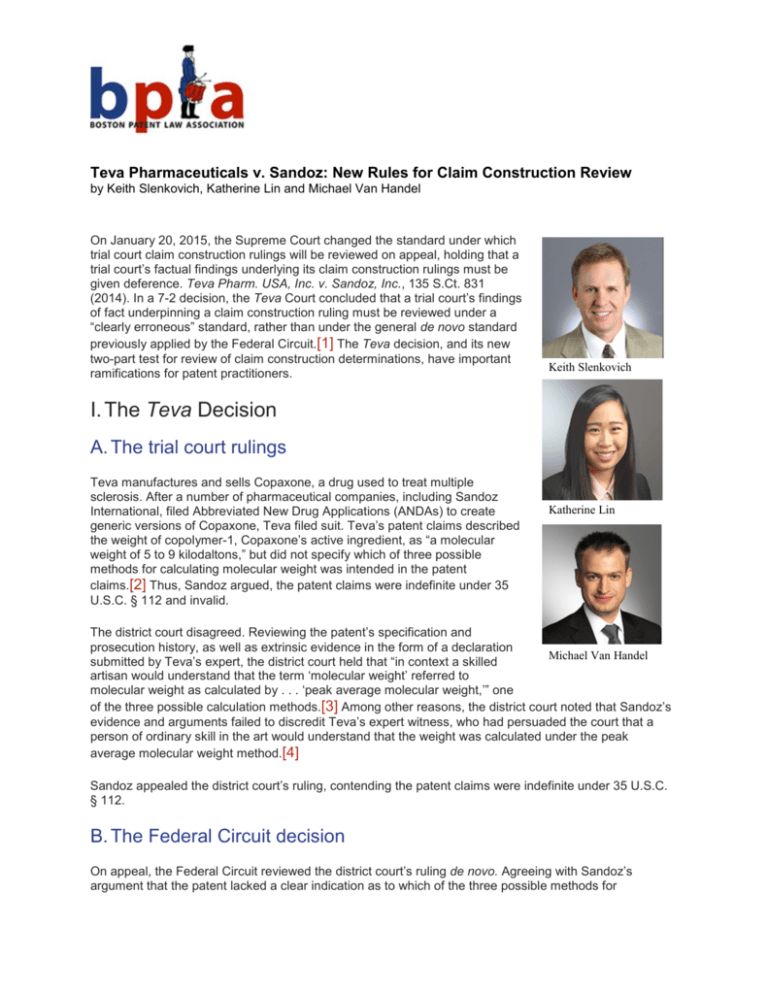
Teva Pharmaceuticals v. Sandoz: New Rules for Claim Construction Review by Keith Slenkovich, Katherine Lin and Michael Van Handel On January 20, 2015, the Supreme Court changed the standard under which trial court claim construction rulings will be reviewed on appeal, holding that a trial court’s factual findings underlying its claim construction rulings must be given deference. Teva Pharm. USA, Inc. v. Sandoz, Inc., 135 S.Ct. 831 (2014). In a 7-2 decision, the Teva Court concluded that a trial court’s findings of fact underpinning a claim construction ruling must be reviewed under a “clearly erroneous” standard, rather than under the general de novo standard previously applied by the Federal Circuit.[1] The Teva decision, and its new two-part test for review of claim construction determinations, have important ramifications for patent practitioners. Keith Slenkovich I. The Teva Decision A. The trial court rulings Teva manufactures and sells Copaxone, a drug used to treat multiple sclerosis. After a number of pharmaceutical companies, including Sandoz International, filed Abbreviated New Drug Applications (ANDAs) to create generic versions of Copaxone, Teva filed suit. Teva’s patent claims described the weight of copolymer-1, Copaxone’s active ingredient, as “a molecular weight of 5 to 9 kilodaltons,” but did not specify which of three possible methods for calculating molecular weight was intended in the patent claims.[2] Thus, Sandoz argued, the patent claims were indefinite under 35 U.S.C. § 112 and invalid. Katherine Lin The district court disagreed. Reviewing the patent’s specification and prosecution history, as well as extrinsic evidence in the form of a declaration Michael Van Handel submitted by Teva’s expert, the district court held that “in context a skilled artisan would understand that the term ‘molecular weight’ referred to molecular weight as calculated by . . . ‘peak average molecular weight,’” one of the three possible calculation methods.[3] Among other reasons, the district court noted that Sandoz’s evidence and arguments failed to discredit Teva’s expert witness, who had persuaded the court that a person of ordinary skill in the art would understand that the weight was calculated under the peak average molecular weight method.[4] Sandoz appealed the district court’s ruling, contending the patent claims were indefinite under 35 U.S.C. § 112. B. The Federal Circuit decision On appeal, the Federal Circuit reviewed the district court’s ruling de novo. Agreeing with Sandoz’s argument that the patent lacked a clear indication as to which of the three possible methods for measuring molecular weight was to be used to determine whether the claims were infringed, the court found that the “molecular weight” term was indefinite. Unlike the district court, the Federal Circuit found that Teva’s expert testimony “[did] not save . . . [the] claims from indefiniteness.”[5] Instead, the Federal Circuit found that conflicting expert testimony offered to the district court by Sandoz indicated that the molecular weight could have been calculated by any of the three methods. The Federal Circuit therefore reversed the district court, finding that the patent claim was indefinite. Teva successfully petitioned for certiorari, arguing that the Federal Circuit should have reviewed the District Court’s findings regarding the alleged indefiniteness of the molecular weight term for clear error, not de novo. C. The Supreme Court’s holding The Supreme Court vacated the Federal Circuit’s judgment and remanded for further proceedings. Writing for the majority, Justice Breyer explained that the ultimate task of construing patent claims is a legal question reviewed de novo. However, to the extent the claim construction exercise involves resolution of subsidiary factual disputes, review of such subsidiary factual findings is for clear error, as directed by Federal Rule of Civil Procedure 52(a)(6). FRCP 52(a)(6) lacks any exceptions, the Court explained, including patent cases. The Teva Court held that the application of FRCP 52(a)(6) was not inconsistent with its prior claim construction decision in Markman v. Westview Instruments, Inc., 517 U.S. 270 (1996). In Markman, the Court had found that patent claim construction was ultimately a question of law, better left to judges than juries. Thus, Markman gave judges exclusive determination of claim construction. What Markman did not do, the Court explained, was create an exception to FRCP 52(a)(6). “Markman no more creates an exception to Rule 52(a) than would a holding that judges, not juries, determine equitable claims, such as requests of injunctions. A conclusion that an issue is for the judge does not indicate that Rule 52(a) is inapplicable.”[6] The Teva Court also noted practical reasons why subsidiary facts in claim constructions are best reviewed under the clear error standard. Because patent law often requires a “‘familiarity with specific scientific problems and principles not usually contained in the general storehouse of knowledge and experience,’” district courts are best positioned to judge a factual dispute.[7] District courts are able to witness the testimony and evidence first-hand, while the Federal Circuit only has access to transcripts.[8] The majority found the Federal Circuit’s reasoning that it would be too difficult to distinguish factual and legal determinations in claim construction reviews to be unconvincing. “Courts of appeals have long found it possible to separate factual from legal matters . . . . [and] the Federal Circuit’s efforts to treat factual findings and legal conclusions similarly have brought with them their own complexities.”[9] The majority also downplayed the Federal Circuit’s concern that reviewing factual determinations under a clear error standard would “allow differing trial court constructions of the same patent, as may result from deferential review of close questions.”[10] The Teva majority doubted that “divergent claim construction stemming from divergent findings of fact (on subsidiary matters) [would] occur more than occasionally,”[11] explaining that “after all, the Federal Circuit will continue to review de novo the district court’s ultimate interpretation of the patent claims.”[12] Other doctrines and practices would also help resolve this issue, the Court reasoned, such as issue preclusion and discovery consolidation. Moreover, the Court predicted that “subsidiary fact finding is unlikely to loom large in the universe of litigated claim construction.”[13] The Teva Court provided guidance as to the types of issues that are considered to be legal determinations as opposed to subsidiary factual findings. Interpretation of evidence “intrinsic to the patent,” i.e., “the patent claims and specification, along with the prosecution history,” is treated as a determination of law reviewed de novo on appeal.[14] However, when the district court consults extrinsic evidence in order to understand “for example, the background science or the meaning of a term in the relevant art during the relevant time period,” findings as to these issues are factual and therefore reviewed for clear error.[15] The ultimate interpretation of the claim in light of subsidiary factual findings remains a legal determination reviewed de novo, although the Court recognized that factual findings may sometimes be dispositive of this ultimate question. Justices Thomas and Alito dissented from the majority opinion, arguing that general de novo review is the proper review standard for all aspects of a claim construction ruling. The dissent argued that FRCP 52(a)(6) does not apply in claim construction determinations, since, according to the dissent, these determinations do not involve findings of fact. This is because, the dissent posited, patents are more analogous to statutes, i.e., written instruments that do not involve subsidiary issues of fact, than to contracts that do involve such subsidiary fact issues (and that the majority described as analogous to patents). The dissent also argued that the need for uniformity supports the de novo review standard. By changing the standard of review to include clear error, patent law will enter a dangerous “‘zone of uncertainty’” that may deter innovation.[16] If inventors are unsure whether patent law will be uniformly applied such that their ideas are protected, they are less likely to invent. “The limits of a patent must be known for the protection of the inventive genius of others and the assurance that the subject of the patent will be dedicated ultimately to the public.”[17] The dissent disagreed with the majority’s claim that there will be few cases that involve subsidiary factfinding. “At best, today’s holding will spawn costly . . . collateral litigation over the line between law and fact.”[18] II. Impact of Teva on Claim Construction Practice It may take years to appreciate the full impact of the Teva decision on patent practice – only time will tell whether Teva will ultimately result in substantially fewer reversals of claim construction rulings by the Federal Circuit. For the time being, it does appear that the Teva decision will, in many cases, make claim construction proceedings and appeals more complicated, due to the two-tier review standard set forth therein. And in all cases, parties and their attorneys will want to analyze whether they should adjust their claim construction strategies to accommodate the new review standard set forth in Teva. A. Submission of extrinsic evidence to support claim construction positions Under Teva, practitioners will want to consider whether extrinsic evidence, which the Federal Circuit had discouraged in Phillips v. AWH, 415 F.3d 1303 (Fed. Cir. 2005), should play a larger role in their claim construction strategies. In Phillips, the Federal Circuit criticized overreliance on extrinsic evidence, describing such evidence as inherently less reliable than intrinsic evidence.[19] Extrinsic evidence, consisting of “all evidence external to the patent and prosecution history, including expert and inventor testimony, dictionary, and learned treatises,” does not have the benefit of being “created at the time of patent prosecution for the purpose of explaining the patent’s scope and meaning,” is less likely to have been “written by or for skilled artisans,” and is created for the purpose of litigation, raising doubts as to its credibility.[20] Because there is a “virtually unbounded universe of potential extrinsic evidence of some marginal relevance,” trial courts must filter through the many pieces of such evidence for credibility and usefulness.[21] And, the Phillips court warned, an overemphasis on extrinsic evidence could lead to the changing of the claims’ meanings from what was intended at the time of the patent’s prosecution, “thereby undermining the public notice function of patents.”[22] The Phillips court did not, however, bar use of extrinsic evidence during claim construction. As that court explained, dictionaries and treaties could in some cases be useful. Technical dictionaries could especially help a court “better understand the underlying technology and the way in which one of skill in the art might use the claim terms.”[23] And expert evidence could be helpful “to provide background on the technology at issue, to explain how an invention works, to ensure that the court’s understanding of the technical aspects of the patent is consistent with that of a person of skill in the art, or to establish that a particular term in the patent or the prior art has a particular meaning in the pertinent field.”[24] But, as the Phillips court noted, expert testimony carries with it the possibility of bias, and can consist of “conclusory, unsupported assertions . . . as to the definition of a claim term [which is] not useful to a court.”[25] For these reasons, when expert testimony is inconsistent with the intrinsic evidence, the Phillips court explained, courts should discount this expert evidence.[26] While the appeal in the Teva case focused on expert testimony, the Teva holding applies to all types of extrinsic evidence, including inventor testimony, dictionaries, and learned treatises. As explained by the majority, FRCP 52(a)(6)’s clear error standard “does not make exceptions or . . . exclude certain categories of factual findings” from the reviewing court’s obligation to accept the lower court’s findings unless there is clear error.[27] The Teva rule “requires appellate courts to review [all subsidiary factual disputes in patent construction] under the clearly erroneous standard.”[28] In view of Teva’s new two-tier standard for reviewing claim constructions, parties should consider hiring an expert to prepare and submit declaratory support in claim construction proceedings, as well as requesting an evidentiary hearing. While the Teva Court explained that the “ultimate construction of the claim” is left to the trial court, expert testimony as to the meaning of a term of art “in general” to a skilled artisan, as well as testimony as to how such a general understanding would be consistent with the specification, can in many cases be strong support for adopting a particular claim construction.[29] Moreover, parties should take into account the different review standards set forth in Teva when considering whether to submit extrinsic evidence. A party submitting extrinsic evidence may be helping to “appeal proof” a favorable claim construction with subsidiary factual findings being reviewed under the clear error standard, as opposed to the purely de novo standard that would be applied in the absence of extrinsic evidence-based factual findings. Conversely, advocating a construction reliant on intrinsic evidence alone may facilitate de novo review. In all cases, parties will want to carefully consider the impact extrinsic evidence will have in both the trial court as well as before the Federal Circuit under Teva’s new two-tier review standard. B. Use of extrinsic evidence in claim construction-based indefiniteness arguments The Teva decision suggests that extrinsic evidence will now play a particularly important role in indefiniteness challenges under 35 U.S.C. § 112. In Teva, the Supreme Court found that the trial court’s ruling of no indefiniteness with respect to the “molecular weight” term should have been given greater deference.[30] Under the logic of Teva, had the trial court reviewed the same extrinsic evidence but reached the opposite finding, i.e., that the term was indefinite, this finding would likewise have been entitled to deference at the Federal Circuit. The Teva decision therefore suggests that extrinsic evidence will be a significant factor in most indefiniteness determinations.[31] A defendant challenging a term as indefinite will want to explore with its expert whether he/she can testify that the term has no specific meaning within the patent or generally in the field of art, and/or that the term has multiple potential meanings all of which would be consistent with the intrinsic evidence. The plaintiff will want to argue, as the plaintiff did in Teva, that one with skill in the art would understand a specific meaning for the term, and that this specific meaning is consistent with the claims, specification and prosecution history. C. Use of live versus declaratory expert testimony Given the Teva Court’s emphasis on the fact-finding role of trial courts in the course of claim construction proceedings, including the trial court’s superior position with respect to assessing the credibility of extrinsic evidence, litigants as well as trial courts may now have stronger incentives to use live witnesses in Markman hearings.[32] In recent years, cost considerations as well as the congested nature of many courtroom dockets have discouraged the use of live expert testimony in claim construction proceedings. But post-Teva, the advantage of assessing the experts in person may in certain cases outweigh the cost and time involved in having experts testify at Markman hearings. District courts may find it valuable to be able to assess the respective experts’ credibility first-hand, in a world where conflicting expert testimony will be deemed a factual dispute to be reviewed only for clear error. Live testimony may also provide a broader spectrum of extrinsic information to the courts, including questioning from the trial court, creating a greater opportunity for “subsidiary factual findings” and support thereof. D. Briefing and argument under the new Teva standards Following Teva, parties can be expected to rely more heavily on expert testimony and other extrinsic evidence in their briefing and argument, thereby maximizing the chances that a favorable claim construction will be upheld on appeal. In briefing and arguments, a party seeking to emphasize such extrinsic evidence will want to identify and/or request specific factual findings that will support that party’s proposed claim constructions. On the other hand, a party that believes it is in a relatively stronger position with respect to intrinsic evidence (or a weaker position with respect to extrinsic evidence), will likely want to argue that extrinsic evidence is unnecessary and/or inappropriate to the particular claim construction determination. These parties will want to emphasize the primacy of intrinsic over extrinsic evidence under the Phillips hierarchy, and argue that any extrinsic evidence offered by the other side is inconsistent with the primary intrinsic record. The frequent practice of stipulating that the parties will not introduce expert testimony to support their respective claim constructions may be affected by the Teva decision. Prior to Teva, it had been common for parties to stipulate, before the exchange of their respective claim constructions, that neither party would rely on declaratory evidence to support their constructions.[33] Given the relatively low weight generally afforded under Phillips to extrinsic declaratory evidence, parties were often motivated to execute such stipulations in order to avoid the expense of developing supporting expert testimony and discovery associated with the testimony. Now, parties that believe they want to achieve supporting factual findings under the new Teva review standard will likely have less incentive to enter into such stipulations. With respect to the impact of Teva on practice before the Federal Circuit, the parties’ respective appellate briefing will likely now include threshold arguments as to whether aspects of the district court’s claim construction rulings should be considered factual or not. A significant aspect of appellate review will undoubtedly now be focused on differentiating between determinations that fall under clear error versus de novo review standards. Because the Federal Circuit will continue to apply de novo review to the ultimate claim construction determination, in cases where the Federal Circuit finds that a claim construction is justified based purely on review of the intrinsic record, it can review the trial court’s determination without deference. If factual determinations are necessary and/or outcome-determinative, a Federal Circuit panel that believes that the district court erred will now have to find that the underlying court’s determination was “clearly erroneous” in order to reverse a claim construction. III. Questions Left Open Following the Teva Decision While the Teva decision will clearly affect several aspects of claim construction practice, the decision left open a number of questions to be settled by the Federal Circuit and district courts. A. Application of Teva holding to mixed intrinsic/extrinsic evidencebased claim constructions The Teva decision suggests that there will be a spectrum of claim construction scenarios with differing impacts from the new “clear error” requirement for subsidiary factual findings. For cases where a claim construction is decided exclusively on the intrinsic record, the standard of review will remain de novo just as before the Teva decision was handed down.[34] Accordingly, where neither party introduces extrinsic evidence, instead limiting their claim construction arguments exclusively to intrinsic evidence, the de novo standard continues to apply: As all parties agree, when the district court reviews only evidence intrinsic to the patent (the patent claims and specifications, along with the patent’s prosecution history), the judge’s determination will amount solely to a determination of law, and the Court of Appeals will review that construction de novo.[35] Under this rule, for instance, where the court construes a claim term solely relying on what it finds to be an unambiguous “special definition” of the claim term within the specification, the review of this determination should be de novo.[36] Indeed, in the first case handed down by the Federal Circuit since Teva, the court confirmed that when the district court confines itself to only intrinsic evidence, the reviewing standard remains exclusively de novo.[37] On the opposite end of the spectrum will be cases where the “general meaning” within the art is the only basis upon which to construe a claim term. If the claims, specification, and prosecution history provide no guidance as to the term’s meaning, the trial court will be left with only extrinsic “general meaning” evidence on which to rely. In such cases, the Teva decision suggests that review of the trial court’s construction will, practically speaking, be a review for “clear error.” As the Teva Court explained: [I]n some instances, a factual finding may be close to dispositive of the ultimate legal question of the proper meaning of the term in the context of the patent. Nonetheless, the ultimate question of construction will remain a legal question. Simply because a factual finding may be nearly dispositive does not render the subsidiary question a legal one. ‘[A]n issue does not lose its factual character merely because its resolution is dispositive of the ultimate’ legal question.[38] In cases where extrinsic evidence indicates that a “general” usage exists for the term at issue outside of the patent, and some intrinsic evidence exists indicative of its meaning, the Teva Court set forth a twopart test: (1) determination of the “general” meaning of the term within the art, followed by (2) determination of whether the term’s usage within the patent is consistent with this general meaning. The Court explained: For example, if a district court resolves a dispute between experts and makes a factual finding that, in general, a certain term of art had a particular meaning to a person of ordinary skill in the art at the time of the invention, the district court must then conduct a legal analysis: whether a skilled artisan would ascribe that same meaning to that term in the context of the specific patent claim under review.[39] While this framework provides a logical construct through which to process the Teva review standard, implementation of this construct may be less well-defined in cases where the intrinsic/extrinsic evidence equation is more complicated (for instance, where extrinsic evidence clearly supports one construction, and intrinsic evidence less clearly supports an opposing construction). The Teva Court explained how the clear error standard should have been applied in the specific context of a factual dispute between the experts as to whether a construction is consistent with the patent’ specification. In the trial court, Sandoz’s expert testified that Teva’s construction was inconsistent with one of the figures in the specification, a chromatogram graph with curves depicting the molecular weights at issue.[40] Teva’s expert, on the other hand, testified that Teva’s construction could be reconciled with the chromatogram graph. The district court found that Teva’s expert’s testimony was more credible.[41] On appeal, the Federal Circuit rejected the district court’s finding, even though it was supported by Teva’s expert’s testimony. According to the Supreme Court, the Federal Circuit should not have rejected this finding unless it found that the finding was “clearly erroneous.” As the Court explained: “Our holding today makes clear that, in failing to do so, the Federal Circuit was wrong.”[42] B. Impact of Teva holding on existing claim construction doctrines One area that remains to be fleshed out following Teva is whether, and how, existing claim construction doctrines will be affected by the new standard of review. The Teva decision provides little guidance as to where bedrock claim construction principles, such as claim differentiation and prosecution history estoppel, fall in terms of the factual versus legal construct set forth in the decision. Under the doctrine of claim differentiation, each claim is presumed to cover a different aspect of the invention from every other claim.[43] Claim differentiation may assist in interpreting the breadth of an independent claim: if a claim depends from that independent claim, then the independent claim must necessarily be broader than the dependent claim. If an expert testifies as to the common usage of a term within the dependent claim in support of a claim differentiation argument, and if the trial’s factual determination as to this common usage is determinative of the resulting claim construction, the Teva decision suggests that review may occur under a de facto clear error standard. Likewise, if, in support of a prosecution estoppel argument, an expert testifies as to what a skilled artisan would understand statements made by the patentee during prosecution to mean, any finding based on this testimony would arguably be factual, to be reviewed for clear error. Another bedrock claim construction principal is the notion that “a claim interpretation that excludes a preferred embodiment from the scope of the claim is rarely, if ever, correct.”[44] In Teva, because the trial court had credited Teva’s expert’s opinion that a chromatogram figure within the patent was consistent with Teva’s proposed construction, the Supreme Court held that this underlying fact should have been reviewed under the clear error standard.[45] Under this logic, if an expert credibly testifies that the other side’s claim construction would exclude a preferred embodiment, and if the trial court accepts this testimony as a basis for its claim construction determination, this finding should likewise be reviewed under a clear error standard. IV. Teva’s Potential Impact on Review of Extrinsic EvidenceBased Factual Findings in PTO Proceedings The Teva decision raises questions with respect to the standard of review the Federal Circuit will apply with respect to extrinsic evidence-based factual findings made by the United States Patent and Trademark Office (“PTO”) in the course of construing terms. Like district courts, the PTO is often called upon to construe terms, for instance in the course of inter partes review proceedings. In view of Teva, claim construction factual findings based on extrinsic evidence filed in PTO proceedings may be given heightened deference. Federal Circuit precedent regarding the standard under which it reviews PTO claim construction decisions has been inconsistent.[46] In In re Morris, 127 F.3d 1048 (Fed. Cir. 1997), the Federal Circuit ruled that the standard for reviewing PTO claim construction decisions is whether the PTO’s interpretation of the disputed claim language is “reasonable.”[47] By contrast, in In re Baker Hughes, 215 F.3d 1297 (Fed. Cir. 2000), the Federal Circuit found that the standard for reviewing PTO claim construction decisions is de novo, the same standard the Federal Circuit used to review all aspects of district court constructions prior to Teva.[48] These decisions regarding review of PTO proceedings did not separately analyze factual determinations that may underlie claim constructions. In 1999, the Supreme Court ruled that appeals of PTO factual determinations are governed by the Administrative Procedures Act (“APA”). Dickinson v. Zurko, 527 U.S. 150, 152 (1999). Under this standard, PTO factual determinations are to be overturned only if they are “arbitrary, capricious, [or] an abuse of discretion” or unsupported by “substantial evidence,” similar to the “clear error” standard set forth in Teva. Applying the Supreme Court’s logic in Teva to review of PTO decisions, review of PTO fact findings underlying claim constructions would be governed under the “substantial evidence” standard of the APA.[49] Accordingly, the Federal Circuit may likewise now give deference to factual determinations made by the PTO in claim construction. Where extrinsic evidence, such as an expert declaration, is relied upon by the PTO in making a factual determination in claim construction, the Federal Circuit may, following the Teva rationale, apply the heightened Dickinson “substantial evidence” standard in reviewing these determinations. In view of the above, patent practitioners may wish to exercise additional caution in submitting extrinsic evidence in a prosecution record during proceedings such as inter partes review. For example, if a practitioner submits extrinsic evidence and receives an unfavorable construction of a claim term based on that evidence, it may now be more difficult to overturn that construction on appeal. Patent practitioners in general exercise caution during prosecution in order to avoid estoppels, but Teva appears to increase the stakes for submission of expert declaration evidence to the PTO. [1]Under the clear error standard, the lower court is given substantial deference, as the court of appeal must accept the district court’s decision unless it has “the definite and firm conviction that a mistake has been made.” Preston v. Marathon Oil Co., 684 F.3d 1276, 1288 (Fed. Cir. 2012). De novo review, in comparison, allows the Federal Circuit to apply the same standard used by the lower court “without deference” to the lower court’s findings. Braintree Labs., Inc. v. Novel Labs., Inc., 749 F.3d 1349, 1354 (Fed. Cir. 2014). [2]Teva, 135 S.Ct. at 832. [3]Id. at 832-33 (citations omitted). [4]Teva Pharm. USA, Inc. v. Sandoz Inc., 810 F. Supp. 2d 578, 591 (S.D.N.Y. 2011). [5]Teva Pharm. USA, Inc. v. Sandoz Inc., 723 F.3d 1363, 1369 (2013). [6]Teva,135 S.Ct. at 838. [7]Id. (citations omitted). [8]As a practical matter, unless live testimony is received at the Markman hearing, this distinction may not be as significant as the Court suggests. District courts usually make rulings based on briefing, declarations and attorney argument, which would equally be available to the Federal Circuit. [9]Id. at 839. [10]Lighting Ballast Control LLC v. Philips Electronics N. Am. Corp., 744 F.3d 1272, 1280 (Fed. Cir. 2014). [11]Teva, 135 S.Ct. at 834. [12] Id. at 839. [13]Id. at 840 (citations omitted). The Teva court failed to address the possibility that, by creating a higher standard of review for factual findings involving extrinsic evidence, the Teva decision itself might encourage the increased use of such extrinsic evidence, and corresponding factfinding, in Markman proceedings. [14]Id. at 841. [15]Id. at 834. [16]Id. at 851 (citation omitted). [17]Id. at 851 (citation omitted). [18]Id. at 852. [19]Phillips v. AWH Corp., 415 F.3d 1303, 1318 (Fed. Cir. 2005). [20]Id. at 1317-18. [21]Id. [22]Id. at 1318-19. [23]Id at 1318. [24]Id. at 1318. [25]Id. [26]Id. [27]Teva Pharm. USA, Inc. v. Sandoz, Inc., 135 S.Ct. 833 (2014) (citations omitted). [28]Id. (citations omitted). [29]Id. at 841. [30] Id. at 843. [31] In Nautilus v. Biosig Instruments, the Supreme Court re-emphasized the importance of the perspective of a person with skill in the art in determining whether a patent claim is sufficiently definite under section 112. 134 S.Ct. 2120, 2128 (2014). Nautilus therefore also encourages parties to consider submitting expert testimony in connection with indefiniteness challenges. [32]Id. at 838 (noting that “sometimes courts may have to make “credibility judgments” about witnesses”). [33]See e.g., N.D.C.A. PATENT L. R. 4-2 Exchange of Preliminary Claim Constructions and Extrinsic Evidence (requiring exchange of expert witness testimony summaries in absence of stipulation). [34]The Teva Court expressed the view that the majority of cases will be decided exclusively on intrinsic evidence. “[A]s we said in Markman, subsidiary factfinding is unlikely to loom large in the universe of litigated claim construction.” Teva, 135 S.Ct. at 840 (citations omitted). It remains to be seen whether the Teva decision itself prompts greater use of extrinsic evidence and, thereby, a higher incidence of subsidiary factfinding in claim construction decisions. [35]Id. at 841. [36]Phillips, 415 F.3d at 1316 (“Consistent with that general principle, our cases recognize that the specification may reveal a special definition given to a claim term by the patentee that differs from the meaning it would otherwise possess. In such cases, the inventor’s lexicography governs.”). [37]In re Papst Licsensing Digital Camera No.14-1110, slip op. at 7, 8 (Fed. Cir. Feb. 2, 2015) (noting that the district court “declined to admit expert testimony or to rely on an expert declaration . . . [because] the intrinsic evidence . . . provide the full record necessary” and as such, the Circuit will “review the district court’s claim constructions de novo, because intrinsic evidence fully determines the proper constructions”) (citation omitted). [38]Teva, 135 S.Ct. at 841-42 (citations omitted). [39]Id. at 841 (emphasis in original). [40]Teva, 135 S.Ct. at 842-43. [41] Id. at 843. [42]Id. [43]Kraft Foods, Inc. v. International Trading Co., 203 F.3d 1362, 1366 (Fed. Cir. 2000) (“Under the doctrine of claim differentiation, two claims of a patent are presumptively of different scope.”). [44]Accent Packaging, Inc. v. Leggett & Platt, Inc., 707 F.3d 1318, 1326 (Fed. Cir. 2013) (quoting On-Line Techs., Inc. v. Bodenseewerk Perkin-Elmer GmbH, 386 F.3d 1133, 1138 (Fed. Cir. 2004)). [45]Teva, 135 S. Ct. at 842-43. [46]Flo Healthcare Solutions, LLC v. Kappos, 697 F.3d 1367, 1376 (Fed. Cir. 2012) (Plager, J., additional views) (noting that “various of our cases seem to apply one or the other of two (possibly three) . . . inconsistent standards” for reviewing claim construction decisions of the Board (the Patent Trial and Appeal Board, formerly the Board of Patent Appeals and Interferences)). [47]Id. at 1377. [48]Id. [49]Id. (“‘We review . . . the Board’s findings of fact for substantial evidence.’”).
